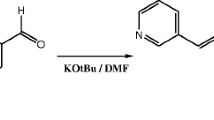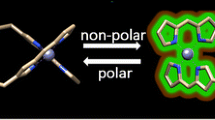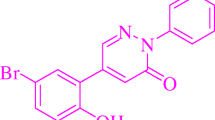Abstract
Room temperature ionic liquids (RTILs) are emerging as a new class of ‘green’ solvents for use in a wide range of chemical processes. RTILs can sensitize or quench fluorescence of organic chemicals and their interactions still remain unclear, especially for weakly fluorescent chemicals. Herein, we report the effects of six RTILs on the fluorescence behavior of bisphenol A (BPA). The fluorescence intensities (FIs) of BPA in a RTIL-acetonitrile system were significantly quenched compared to acetonitrile. The quenching effect was stronger for [CnMIM]BF4 than [CnMIM]PF6. A decreasing trend of fluorescence lifetime (FL) of BPA was observed for [C6MIM]PF6 (4.26 to 3.86 ns) and [C14MIM]PF6 (4.15 to 3.78 ns) with increasing RTIL concentrations in the range of 1–10 mM. The quenching mode was consistent with a static quenching mechanism based on the consistency of FL and FI results. The emission bands of BPA and RTILs did not interfere with each other when RTILs were used as the solvent. The investigated RTILs enhanced the FIs of strongly fluorescing chemicals (12.0 ~ 19.0-fold for norfloxacin and 6.1 ~ 8.5-fold for dansyl chloride), but quenched those of weakly fluorescing chemicals (BPA). These results demonstrate that RTILs have different fluorescent effects on organic chemicals with different fluorophores. The interactions between RTILs and BPA result from many factors in addition to viscosity, such as solvent electrostatic dielectric constant, refractive index, density, polarization and molecular interaction. These results provide a theoretical foundation for application of RTILs in the analysis of weakly fluorescing chemical.










Similar content being viewed by others
References
Sun P, Armstrong DW (2010) Ionic liquids in analytical chemistry. Anal Chim Acta 661:1–16
Vygodskii YS, Mel’nik OA, Lozinskaya EI, Shaplov AS, Malyshkina IA, Gavrilova ND, Lyssenko KA, Antipin MY, Golovanov DG, Korlyukov AA, Ignat’ev N (2007) The influence of ionic liquid’s nature on free radical polymerization of vinyl monomers and ionic conductivity of the obtained polymeric materials. Polym Adv Technol 18:50–63
Mutelet F, Revelli AL, Jaubert JN, Sprunger LM, Acree WE Jr, And Baker GA (2010) Partition coefficients of organic compounds in new imidazolium and tetralkylammonium based ionic liquids using inverse gas chromatography. J Chem Eng Data 55:234–242
Wakai C, Oleinikova A, Ott M, Weingärtner H (2005) How polar are ionic liquids? Determination of the static dielectric constant of an imidazolium-based ionic liquid by microwave dielectric spectroscopy. J Phys Chem B 109:17028–17030
Vidal L, Riekkola ML, Canals A (2012) Ionic liquid-modified materials for solid-phase extraction and separation: a review. Anal Chim Acta 715:19–41
Guerra-Abreu L, Pino V, Anderson JL, Afonso AM (2008) Coupling the extraction efficiency of imidazolium-based ionic liquid aggregates with solid-phase microextraction-gas chromatography–mass spectrometry: application to polycyclic aromatic hydrocarbons in a certified reference sediment. J Chromatogr A 1214:23–29
Tao Y, Liu FJ, Hu XL, Li HC, Wang T, Jiang GB (2009) Hollow fiber supported ionic liquid membrane microextraction for determination of sulfonamides in environmental water samples by high-performance liquid chromatography. J Chromatogr A 1216:6259–6266
Cruz-Vera M, Lucena R, Cardenas S (2009) One-step in-syringe ionic liquid-based dispersive liquid–liquid microextraction. J Chromatogr A 1216:6459–6465
Bian M, Zhang ZJ, Yin H (2012) Effects and mechanism characterization of ionic liquids as mobile phase additives for the separation of matrine-type alkaloids by liquid chromatography. J Phar Biomed Anal 58:163–167
Martín-Calero A, Pino V, Ayala JH, González V, Afonso AM (2009) Ionic liquids as mobile phase additives in high-performance liquid chromatography with electrochemical detection: application to the determination of heterocyclic aromatic amines in meat-based infant foods. Talanta 79:590–597
Breitbach ZS, Armstrong DW (2008) Characterization of phosphonium ionic liquids through a linear solvation energy relationship and their use as GLC stationary phases. Anal Bioanal Chem 390:1605–1617
Payagala T, Zhang Y, Wanigasekara E, Huang K, Breitbach ZS, Sharma PS, Sidisky LM, Armstrong DW (2009) Trigonal tricationic ionic liquids: a generation of gas chromatographic stationary phases. Anal Chem 81:160–173
Bose S, Wijeratne AB, Thite A, Kraus GA, Armstrong DW, Petrich JW (2009) Influence of chiral ioinic liquids on stereoselective fluorescence quenching by photoduced electron transfer in a naproxen dyad. J Phys Chem B 113:10825–10829
Devi VS, Maji S, Viswanatha KS (2011) Novel room temperature ionic liquid for fluorescence enhancement of Eu3+ and Tb3+. J Lumin 131:739–748
Wu H, Zhang LB, Du LM (2011) Ionic liquid sensitized fluorescence determination of four isoquinoline alkaloids. Talanta 85:787–793
Wang XD, Li YY, Du XW, Lin ZK, Huang CJ (2011) Effects of room temperature ionic liquids on fluorescence characteristics of 17β-estradiol and its derivative. J Fluoresc 21:1643–1648
Zou YJ, Wang HL, Wang WW, Ma MP, Wang P, Wang CJ, Wang XD (2012) The effect of imidazolium room temperature ionic liquids on the fluorescent properties of Norfloxacin. Luminescence doi:10.1002/bio.1382
Wang X, Zeng HL, Zhao LX, Lin JM (2006) Selective determination of bisphenol A (BPA) in water by a reversible fluorescence sensor using pyrene/dimethyl β-cyclodextrin complex. Anal Chem Acta 556:231–318
Vandenberg LN, Hauser R, Marcus M, Olea N, Welshons WV (2007) Human exposure to bisphenol A (BPA). Reprod Toxicol 24:139–177
Sajiki J, Yonekubo J (2004) Leaching of bisphenol A (BPA) from polycarbonate plastic to water containing amino acids and its degradation by radical oxygen species. Chemosphere 55:861–867
Braunrath R, Cichna M (2010) Sample preparation including sol-gel immunoaffinity chromatography for determination of bisphenol A in canned beverages, fruits and vegetables. J Chromatogr A 1062:189–198
Xu JG, Wang ZB (2006) Fluorimetry, 3rd edn. Science and Technology Press, China
Fletcher KA, Pandey S, Storey IK, Hendricks AE, Pandey S (2002) Selective fluorescence quenching of polycyclic aromatic hydrocarbons by nitromethane within room temperature ionic liquid 1-butyl-3-methylimidazolium hexafluorophosphate. Anal Chim Acta 453:89–95
Deng YQ (2006) Ionic liquid: property, synthesis and applications. China Petrochemical Press, Beijing
Hyun BR, Dzyuba SV, Bartsch RA, Quitevis EL (2002) Intermolecular dynamics of room-temperature ionic liquids: femtosecond optical kerr effect measurements on 1-alkyl-3-methylimidazolium bis((trifluoromethyl)sulfonyl)imides. J Phys Chem A 106:757
Ho TD, Canestraro AJ, Anderson JL (2011) Ioniic liquids in solid-phase microextraction: a review. Anal Chim Acta 695:18–43
Huddleston JG, Visser AE, Reicher WM (2001) Characterzation and comparison of hydrophilic and hydrophobic room temperature ionic liquids incorporating the imidazolium cation. Green Chem 3:156–164
Geng F, Zheng L, Yu L, Li G, Tung C (2010) Interaction of bovine serum albumin and long-chain imidazolium ionic liquid measured by fluorescence spectra and surface tension. Process Biochem 45:306–311
Obliosca JM, Arco SD, Huang MH (2007) Synthesis and optical properties of 1-alkyl-3-methylimidazolium lauryl sulfate ionic liquids. J Fluoresc 17:613–618
Paul A, Mandal PK, Samanta A (2005) On the optical properties of the imidazolium ionic liquids. J Phys Chem B 109:9148–9153
Acknowledgments
This work was jointly funded by the National Natural Science Foundation of China (21077079), Natural Science Foundation of Zhejiang Province (LY13B070011, LY13D010006), Key Project of Environmental Protection Department of Zhejiang Province (2012B014), International Cooperation Project of Wenzhou City (H20100053) and Public Benefit Project of Zhejiang Province (2011C37006).
Author information
Authors and Affiliations
Corresponding authors
Rights and permissions
About this article
Cite this article
Wang, H., Zou, Y., Li, C. et al. Fluorescence Characteristics of Bisphenol A in Room Temperature Ionic Liquids. J Fluoresc 23, 1157–1165 (2013). https://doi.org/10.1007/s10895-013-1246-2
Received:
Accepted:
Published:
Issue Date:
DOI: https://doi.org/10.1007/s10895-013-1246-2




